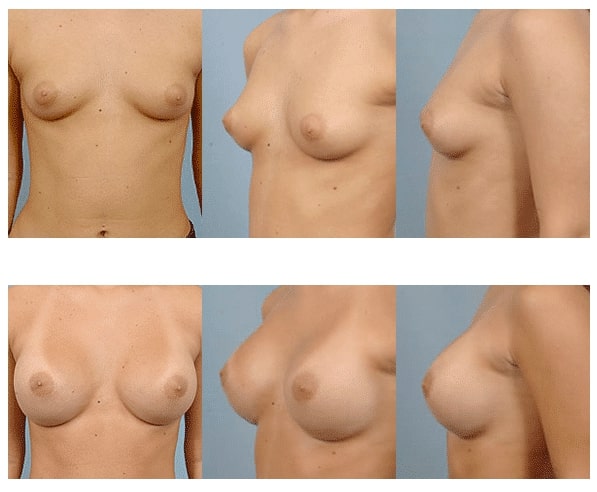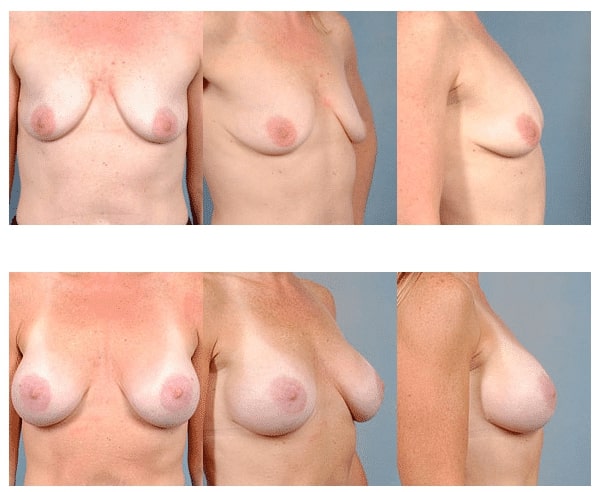Augmentation of Type I and Type II Breasts
I Subdivide All Breasts (Who Are Candidates For An Augmentation WITHOUT Needing A Lift) Into Two Categories:
- Breast Type I – The small, perky breast: these breasts are usually size A but occasionally a small B cup with a tight soft tissue envelope and no bottoming out of the breast. When I say “bottoming out” I mean that there is breast tissue that lies below the lower breast crease when looking from the side of the breast.
- Breast Type II – The lax or postpartum breast: these breasts have lost fullness in the upper lateral (outside) of the breast and in the front. The glandular tissue sags below the lower breast crease. The nipple lies at or above the lower breast crease when viewed from the side.
Breast Type I
The anticipated aesthetic result from breast augmentation in both of these cases is considerably different, and that is what I refer to as the “limitations imposed by the tissues.” The small, perky, tight breast will remain perky with little if any sag below the lower breast crease. The nipple will move forward. Some women like these breasts because they retain upper breast fullness and look large; however, they look less natural. One must be careful with these breasts because any attempt to over-augment these breasts might result in excessive stretching of the lower breast and/or descent of the lower breast crease with loss of upper breast fullness causing the nipple to appear too high (bottoming out of the breasts).
My approach is to determine ahead of time the ideal fill volume of the breast so as to minimize the risk of lower pole (breast) stretching, although that risk can only be minimized, not completely eliminated. There is no way, at least in the short term, that these breasts will have a straight slope on the top of the breast and a gentle curve of lower breast fullness that lies below the lower breast crease. The breast tissue is tight! It will take time, perhaps four to twelve months or so for the breast tissue to relax and settle to a stable result. That is the limitation of the tissues. This does not mean that you cannot achieve a beautiful result with breast augmentation; you certainly can, but you need to understand before surgery what the anticipated look will be after surgery.

Breast Type II
Augmentation of the lax or postpartum breast gives a totally different look. The loss of superior fullness can be restored. Initially, this fullness is very high and many women love it, even though it looks a bit unnatural. As the breast re-models/re-shapes in about four months or so (I don’t like to say the implant drops because it doesn’t in most cases), this fullness changes from an upper convexity to a straight or slightly convex upper slope.
Many women post questions in the online forums about what size implant will give their postpartum breast a full upper pole, but the reality is that no implant will do this on a long term basis; the breast will simply overstretch and descend under the weight of the over-sized implant.
Unfortunately, with this type of breast, if you want that upper pole fullness, you will require the assistance of a bra. Again, this is not a deterrent to surgery; I find breasts of this tissue type to yield absolutely spectacular, natural results. They do require some extra work on my end during surgery to achieve this, but the results are definitely worth the effort expended.

under the muscle using a dual plane III technique
Topics - What Size Implant Should I get
- Achieving a natural look with breast augmentation
- Types of Breasts
- Choosing the Proper Implant Volume (Size)
- Soft Tissue-Based Planning to Determine Implant Size
- 3D Computer Simulation Of Breast Augmentation With Vectra® 3D
- 3D Computer Simulation of Breast Augmentation with Crisalix®
- Implant Selection for Selective Volumization of the Breast (Preservé Only)
- Social Media, Friends/Family & Implant Size – Why Total Breast Size is Better
Prev Section: What Implant Type Do I need? »
Next Section: Pocket location – Above or below the muscle? »
Sections – Five Key Decisions You Need To Make
Chapters – Breast Augmentation Guide
- Intro to Breast Augmentation
- Preservation Breast Augmentation – A New Era!
- Motiva Implants – What You Need to Know
- Five key decisions you need to make
- One-Day Recovery Breast Augmentation
- Anesthesia – General, Sedation or Local?
- Breast Lift (Mastopexy) with/without Implants or Fat
- What else should I know about breast augmentation?
- Important Things to Consider When You Decide to Move Forward With Breast Augmentation
- Revision of breast augmentation
- ALCL and Breast Implant Illness


